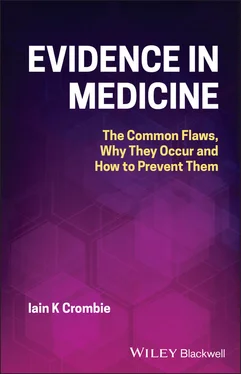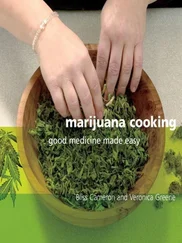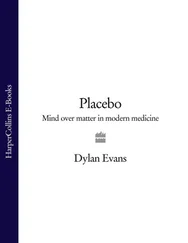The response to a sham treatment is known as a placebo effect. Understanding of the psychological and physiological factors underlying the placebo response has advanced greatly in recent years [51, 52]. A consistent finding is that patients who have high expectations of their treatment usually experience improvements in symptoms. If patients were aware of their treatment allocation, only those in the active group would have the high expectations. Concealment of treatment allocation could prevent this bias from creating difference between the groups.
Obtaining evidence on treatment effectiveness is a challenging business. As Passamani remarked in 1991, ‘The history of medicine is richly endowed with therapies that were widely used and then shown to be ineffective or frankly toxic’ [53]. A similar view was expressed by the celebrated American physician, Oliver Wendell Holmes in 1860, ‘if the whole materia medica, as now used, could be sunk to the bottom of the sea, it would be all the better for mankind – and all the worse for the fishes’ [54]. These may seem somewhat jaundiced views, but they reflect the large proportion of ineffective and possibly harmful treatments that were once used. Even in the early years of the twentieth century many ineffective treatments were widely used [55], and some treatments of little value continue to be used today [56]. Concern about this has led to a recent international campaign, ‘Choosing Wisely’, to reduce the use of ineffective or harmful treatments [57].
This chapter has presented examples of different approaches used to identify potentially effective treatments. Reliance on theories of disease processes is often unreliable and can result in harmful treatments being used. Careful observation of treatment outcomes in a series of patients can, if the benefits are immediate and substantial, identify effective treatments. Comparisons of groups of patients given different treatments are often more insightful, but are vulnerable to the criticism that the groups might not be similar at baseline. As the eminent French physician P C A Louis pointed out in 1834, ‘it is necessary to account for differences of age, sex, temperament, physical condition, natural history of the disease’ [58]. The use of groups constructed to be similar on some factors at baseline is a definite improvement, but leaves open the question that they differ on other (unmeasured) factors. Allocation of individual patients to treatments using random numbers overcomes two problems: clinician bias in assigning patients to groups, and differences in unmeasured factors.
The sequence of methods presented in this chapter could be taken to imply that there was a steady progression to increased robustness of study design. However, as the dates for the individual studies show, there is little evidence for continuous improvement in methods: rather there was substantial overlap in the use of these methods. The major advances in trial methodology occurred in studies conducted in the middle of the twentieth century. They used three techniques that are now hallmarks of high quality trials: randomisation, blinding of the investigators and patients to the randomisation process, and objective outcome measures.
In summary, this chapter has reviewed the development of methods to evaluate treatments up to the middle of the twentieth century. It has highlighted pitfalls of many of the earlier methods and concluded with an outline of the advantages of the double blind randomised controlled trial. This method is now used around the world to identify the benefits of treatments. Medicine now has the tools to ensure that only effective treatments are used. The next chapter explores whether the benefits of the randomised controlled trial have been realised.
1 1. Porter, R. (1999). The Greatest Benefit to Mankind. London: Harpers Collins.
2 2. Cantu, J.Q. (1965). Benjamin Franklin's medical imprints. Bull. Med. Libr. Assoc. 53: 71–79.
3 3. Bhatt, A. (2010). Evolution of clinical research: a history before and beyond Lames Lind. Perspect. Clin. Res. 1: 6–10.
4 4. Ackerknecht, E.H. (1982). A Short History of Medicine. Baltimore: Johns Hopkins University Press.
5 5. DePalma, R.G., Hayes, V.W., and Zacharski, L.R. (2007). Bloodletting: past and present. J. Am. Coll. Surg. 205: 132–144.
6 6. Risse, G.B. (1979). Renaissance of bloodletting – chapter in modern therapeutics. J. Hist. Med. Allied Sci. 34: 3–22.
7 7. Stokes, W. (1865). The address in medicine. BMJ ii: 133–142.
8 8. Biggio, J.R. Jr. (2013). Bed rest in pregnancy: time to put the issue to rest. Obstet. Gynecol. 121: 1158–1160.
9 9. Sprague, A.E. (2004). The evolution of bed rest as a clinical intervention. J. Obstet. Gynecol. Neonatal. Nurs. 33: 542–549.
10 10. Bigelow, C. and Stone, J. (2011). Bed rest in pregnancy. Mt Sinai J. Med. 78: 291–302.
11 11. McCall, C.A., Grimes, D.A., and Lyerly, A.D. (2013). ‘Therapeutic’ bed rest in pregnancy: unethical and unsupported by data. Obstet. Gynecol. 121: 1305–1308.
12 12. Brower, R.G. (2009). Consequences of bed rest. Crit. Care Med. 37: S422–S428.
13 13. Jack, D.B. (1997). One hundred years of aspirin. Lancet 350: 437–439.
14 14. Montinari, M.R., Minelli, S., and De Caterina, R. (2019). The first 3500years of aspirin history from its roots – a concise summary. Vasc. Pharmacol. 113: 1–8.
15 15. Vane, J.R., Flower, R.J., and Botting, R.M. (1990). History of aspirin and its mechanism of action. Stroke 21: IV12–IV23.
16 16. Rosenfeld, L. (2002). Insulin: discovery and controversy. Clin. Chem. 48: 2270–2288.
17 17. Banting, F.G. (1926). An address on diabetes and insulin: being the Nobel lecture delivered at Stockholm on September 15th, 1925. CMAJ 16: 221–232.
18 18. Banting, F.G., Best, C.H., Collip, J.B. et al. (1922). Pancreatic extracts in the treatment of diabetes mellitus. CMAJ 12: 141–146.
19 19. Karamitsos, D.T. (2011). The story of insulin discovery. Diabetes Res. Clin. Pract. 93 (Suppl 1): S2–S8.
20 20. Wangensteen, O.H., Wangensteen, S.D., and Klinger, C.F. (1972). Wound management of Ambroise pare and Dominique Larrey, great French military surgeons of the 16th and 19th centuries. Bull. Hist. Med. 46: 207–234.
21 21. Drucker, C.B. (2008). Ambroise pare and the birth of the gentle art of surgery. Yale J. Biol. Med. 81: 199–202.
22 22. Huth, E. (2006). Quantitative evidence for judgments on the efficacy of inoculation for the prevention of smallpox: England and New England in the 1700s. J. R. Soc. Med. 99: 262–266.
23 23. Bird, A. (2019). James Jurin and the avoidance of bias in collecting and assessing evidence on the effects of variolation. J. R. Soc. Med. 112: 119–123.
24 24. Charles, D. and Larsen, B. (1986). Streptococcal puerperal sepsis and obstetric infections: a historical perspective. Rev. Infect. Dis. 8: 411–422.
25 25. Adriaanse, A.H., Pel, M., and Bleker, O.P. (2000). Semmelweis: the combat against puerperal fever. Eur. J. Obstet. Gynecol. Reprod. Biol. 90: 153–158.
26 26. Chalmers, I., Dukan, E., Podolsky, S. et al. (2012). The advent of fair treatment allocation schedules in clinical trials during the 19th and early 20th centuries. J. R. Soc. Med. 105: 221–227.
27 27. Burnby, J. and Bierman, A. (1996). The incidence of scurvy at sea and its treatment. Rev. Hist. Pharm. 44: 339–346.
28 28. Baron, J.H. (2009). Sailors' scurvy before and after James Lind – a reassessment. Nutr. Rev. 67: 315–332.
29 29. Milne, I. (2012). Who was James Lind, and what exactly did he achieve. J. R. Soc. Med. 105: 503–508.
30 30. Bartholomew, M. (2002). James Lind's treatise of the scurvy (1753). Postgrad. Med. J. 78: 695–696.
Читать дальше












